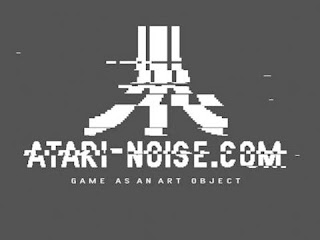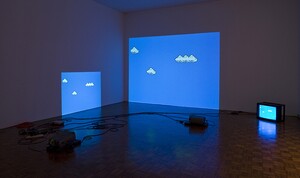Tom Betts
Computer generated art is sometimes forgotten about, but it is a growing and continually fascinating arena of practice that overlaps the world of systems art and gaming. Coding of course is a very important element within these types of practices.
Frederick Hammersley was one of the first artists to see the potential of computer coding as a way of generating imagery, you can see the relationship between his work and other process led work here.
Frederick Hammersley: Computer generated image 1969
In
England it was probably the work of Harold Cohen that first came to the
public's attention. He used a program called AARON, which drove a robotic machine that could make large
drawings on sheets of paper placed on the floor.
Harold Cohen: 1982
I have briefly touched on these issues before, in particular read the notes on the work of Corneel Cannearts. The
history of this type of work is something I must admit to not being fully
cognisant of. However what I can do is offer a few pointers to those of you
wanting to open out your own research into the area. The work of Nam
June Paik was probably what first alerted me to the importance of the
electronic manipulation of imagery. Paik with technical support, developed
a video synthesizer that allowed him to mix and manipulate colours and shapes
from different images. He stated at the time, "This will enable us to
shape the TV screen canvas as precisely as Leonardo, as freely as Picasso, as
colourfully as Renoir, as profoundly as Mondrian, as violently as Pollock and
as lyrically as Jasper Johns". (Edith Decker, Paik Video, S. 152.)
Sometimes Paik's work can be too easily seen as simply to do with his
appropriation of numerous TV sets and building them into towers or robot like
sculptures. He was also deeply involved with how electronic media operated, was
very interested in why electronic images were like they were, and was using
theories taken from Marshall McLuhan's
concept of 'the medium is the message', in order to justify his
experiments.
Artists such
as John F. Simon Jr. have pointed out the similarities between concept-based
and software-based art. "I see parallels between my work and works by
those like Lawrence Weiner and Sol LeWitt at the end of the sixties,"
states Simon. "Their wall sketches especially were nothing more than a set
of instructions…I believe that software and programming are a natural
continuation of this concept because software is basically nothing more than a
set of instructions… The ideas of some concept artists could be written as
programs and could then be implemented by a computer. The art works would then
simply produce themselves. Or, more simply: art does what it says. That’s
the way I look at my programs." (Baumgärtel,
2001, p.103) Simon has also made the link between his work and
LeWitt's in a much more direct way. See.
John F. Simon Jr.: 'Combinations'
For those of you wanting to look at creative coding, I am told that 'Processing', and 'openFrameworks' an open source C++ toolkit are good places to begin. Raven Kwok is an Openprocessing user and he is worth looking at if you want to get an idea of much more contemporary work in this area. You can get an idea of Kwok and how he works from the clip below of Kwok introducing himself.
Raven Kwok
Davidope is the pseudonym of animated GIF artist David Szakaly. Even someone as digitally challenged as myself has been able to make animated GIFs, so this area of working might be a place to start if you have never thought of making images for a computer screen before. Davidope has used GIFs to revisit concepts such as those investigated by Bridget Riley back in the 1960s. The issue about GIFs is that they take up very little computer memory and therefore they can be accessed on a wide range of devices; you also don't need to understand coding to begin making interesting things.
Davidope: Animated GIF
Florian Cramer has emphasised what has been called the 'defect paradigm' in many computer artist's interactions. This is probably due to the fact that artists are not necessarily good programers. He sees destruction or creative modification as the focus of works that specifically concentrate on using the graphic qualities of games as visual raw materials, such as Arcangel Constantini's "Atari Noise"
Arcangel Constantini's "Atari Noise"
Play Arcangel Constantini's "Atari Noise"
Although I understand the conceptual game being played in 'Atari Noise' and of course its relationship with mathematical variation and systems art, I personally much prefer Cory Arcangel's 'Super Mario Clouds'. Based on the Nintendo NES game; Cory Arcangel hacked the game and modified it so that all that remains of the game are the white clouds on a blue sky. Cory Arcangel had to open the cartridge, on which the game was stored, and replace the Nintendo graphics chip with a chip on which he had burned a program he had written himself.
Cory Arcangel's 'Super Mario Clouds'
Much more recently Larry Achiampong & David Blandy in 'Finding Fanon 2' which is available as a UHD video, have combined art-house cinema with machinima. It has been stated that, "their work investigates the post-colonial condition within the simulated world of Grand Theft Auto V. The result is a multi-layered narrative which raises questions about the alleged ideology-free spaces of video games". Metamakers Institute
Larry Achiampong & David Blandy: Finding Fanon 2
The issue about Cory Arcangel or Larry Achiampong & David Blandy's work is that it is work that transcends the boundaries of computer game art, becoming simply 'art', the fact it is using computer game technologies is no longer the be all and end all issue for the work. Like Hito Stereyl they use technologies as part of the way they think about ideas. See Hito Stereyl playing with ideas associated with the technologies of video making.
'Listening Post' was the first piece of computer assisted art that I thought worked as well as any other. Even though it was made way back in 2001 it still feels contemporary, therefore I would suggest it is the concept rather than the technology that carries the weight of the idea.
See also:
The work of Rachel Ara is a good place to start if you are interested in a more feminist stance in relation to work in this field.
Mark Hansen and Ben Rubin: Listening Post
'Listening Post' was the first piece of computer assisted art that I thought worked as well as any other. Even though it was made way back in 2001 it still feels contemporary, therefore I would suggest it is the concept rather than the technology that carries the weight of the idea.
See also:
The work of Rachel Ara is a good place to start if you are interested in a more feminist stance in relation to work in this field.
Machinima is not a game (an overview of contemporary practices)
Network Art: Practices and Positions edited by Tom Corby: See the chapter 'The Ludic Hack' in particular p.85 for some interesting comments on the relationship between Arcangel Constantini's "Atari Noise" and the work of Nam June Paik.
Ten theses about software art
Computer programming as an art
Raven Kwok site
Computer programming as an art
Raven Kwok site
Processing: A Programming Handbook for Visual Designers and Artists (The MIT Press) by Casey Reas is a good book to look at if you want to begin the process of learning coding.
The work of Darrell Viner
Revisiting John Berger's Ways of Seeing in the digital age
The work of Darrell Viner
Revisiting John Berger's Ways of Seeing in the digital age









No comments:
Post a Comment